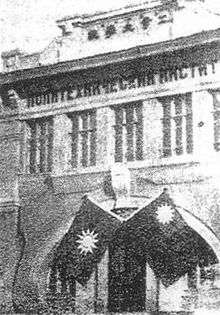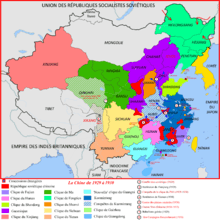Central Plains War
The Central Plains War (traditional Chinese: 中原大戰; simplified Chinese: 中原大战; pinyin: Zhōngyúan Dàzhàn) was a series of military campaigns in 1929 and 1930 that constituted a Chinese civil war between the Nationalist Kuomintang government in Nanjing led by Generalissimo Chiang Kai-shek and several regional military commanders and warlords that were former allies of Chiang.
After the Northern Expedition ended in 1928, Yan Xishan, Feng Yuxiang, Li Zongren and Zhang Fakui broke off relations with Chiang shortly after a demilitarization conference in 1929, and together they formed an anti-Chiang coalition to openly challenge the legitimacy of the Nanjing government. The war was the largest conflict in the Warlord Era, fought across Henan, Shandong, Anhui and other areas of the Central Plains in China, involving 300,000 soldiers from Nanjing and 700,000 soldiers from the coalition.[11]
Background
Rise of Chiang Kai-shek
Compared to other senior party officials like Hu Hanmin and Wang Jingwei, the political status of Chiang Kai-shek in the Kuomintang (KMT) was lower in the beginning. Chiang began his rise to prominence in 1917 during the Constitutional Protection Movement and the formation of the Guangzhou government, where he displayed his military talent. The turning point came in 1923 when Chen Jiongming launched a rebellion against Sun Yat-sen in Guangzhou. Chiang's role in helping Sun to retreat from Guangzhou ultimately helped him to become Sun's protégé.[12]
After Sun's death in 1925, factions within the Kuomintang began to surface. A power struggle between Chiang and Wang Jingwei led to the split of the KMT. Chiang was able to use his influence as the commandant of the Whampoa Academy and eventually took over the leadership of the party, forcing Wang into exile overseas. In 1926, Chiang was ceremonially chosen as the commander of the newly formed National Revolutionary Army and launched the Northern Expedition. In the course of the expedition, Chiang had managed to form an alliance with warlord armies of Feng Yuxiang, Yan Xishan and Li Zongren.[13]
Reunification of China (1928)



| Central Plains War | |||||||||
|---|---|---|---|---|---|---|---|---|---|
| Traditional Chinese | 中原大戰 | ||||||||
| Simplified Chinese | 中原大战 | ||||||||
| |||||||||
The Northern Expedition ended with the reunification of China in 1928 under the Nanjing government, as Zhang Xueliang declared the allegiance of his Northeast Army to the Nationalist government in Nanjing, following the assassination of his father Zhang Zuolin by the Japanese Kwantung Army. While Chiang emerged as the paramount leader of the Republic of China, the reunification soon ran into issues as different factions in the Kuomintang disagreed over demilitarization at a military conference in 1929.[14] The National Revolutionary Army was reorganized into four army groups after the Northern Expedition, incorporating armies from regional warlords. The First Army Group was formed by the Whampoa clique, alternatively known as the Central Army, which were directly led by Chiang himself. The Second Army Group consisted of elements from Guominjun led by Feng Yuxiang. The Third Army Group was led by Yan Xishan of the Shanxi clique, while the Fourth Army Group were led by Li Zongren of the New Guangxi clique.[15]
First phase
Formation of anti-Chiang coalitions, first conflicts
Following the demilitarization conference in 1929, Li Zongren, Bai Chongxi and Huang Shaohong of the Guangxi clique broke off relations with Chiang in March 1929, which effectively started the confrontation between these commanders and the Nanjing government. In May, Feng Yuxiang of the Northwest Army also clashed with Chiang. In November, Li Zongren issued a declaration to form anti-Chiang coalition along with Wang Jingwei. In December, Tang Shengzhi and Zhang Fakui announced their support of the anti-Chiang coalition. The Nanjing government responded by expelling Wang Jingwei from the party for his participation in the anti-Chiang coalition. The coalition created a new KMT government in Beijing to show their defiance of the Nanjing government. In February 1930, Yan Xishan of the Shanxi clique demanded the resignation of Chiang from the KMT, which was refused. Later in the same month, Yan assumed the leadership position in the anti-Chiang coalition, with the assistance of Feng and Li while Zhang Xueliang chose to remain "loyal" to Chiang.[16]
Allies of Chiang Kai-shek
The Nanjing government enjoyed support from the Chinese Muslims of the Gansu province in Northwest China. While the region was originally under the sphere of influence of the Northwest Army, influential Muslim leaders including Ma Tingrang, Ma Zhongying and Ma Fuxiang broke off relations with Feng Yuxiang in 1928. Forces of the Chinese Muslims remained loyal to the Nanjing government through the war, diverting forces of Feng away from the Central Plains.[17]
Preparations for the second phase

The anti-Chiang coalition planned their renewed attack on the Nationalist government in Nanjing through different routes. Li Zongren was expected to lead the Guangxi Army from Guangxi and toward Hunan to threaten the stronghold of Chiang in Wuhan. Feng Yuxiang would lead the Northwest Army and march from Henan to Shandong, attacking Xuzhou while also applying pressure on Wuhan. Yan Xishan would lead the Shanxi Army and coordinate with the Northwest Army to strike Xuzhou together, and march toward Nanjing after Xuzhou is captured by the coalition.
In response to the preparations, the Nationalists assigned Han Fuqu to set up defense in the southern bank of the Yellow River to counter the Shanxi Army. Main forces of the Nationalists would be stationed in Xuzhou to await for impending offensives.[18]
Second phase
Chiang offensives (May – June 1930)

On 11 May, the Central Army led by Chiang Kai-shek launched a series of general offensives against Yan Xishan and Feng Yuxiang. Following the Longhai Railway, the Central Army marched westward from Xuzhou, reaching the outskirts of Kaifeng in the Henan province by 16 May. The Northwest Army, being the strongest in the anti-Chiang coalition, crushed the Central Army led by Chen Cheng in Gansu by the end of May, with Chiang having escaped from near capture.[19] The Northwest Army could not capitalize on its victory, however, as the Shanxi Army was unable to arrive on time to deliver further damage to the Central Army. With the allies of Chiang in Gansu province, the Northwest Army turned to defense following the victory. In Kaifeng the Northwest Army repelled attacks by Chiang's forces, inflicting heavy casualties. The combined forces of Shanxi Army and the Northwest Army later engaged in the largest conflict of the war in their attack on Xuzhou, with both sides sustaining combined casualties exceeding 200,000. The Shanxi Army retreated from Jinan and took further losses while crossing the Yellow River. The lack of coordination between forces of the anti-Chiang coalition was the beginning of the tide turning for the Nanjing government.[20]
Change of tides (June – September 1930)
In the southern battlefields the Guangxi Army led by Li Zongren and Bai Chongxi marched northwards and captured Yueyang, but Chiang's forces managed to cut them off from behind, eventually forcing them to withdraw to their home province. In Shandong the Shanxi Army captured Jinan on 25 June. After defeating the Guangxi Army in Hunan, the Nanjing government decided to launch a major counteroffensive against the Shanxi Army in Shandong. Marching from Qingdao, Chiang's forces retook Jinan on 15 August. The Central Army then amassed troops in Gansu and Shaanxi provinces, launching their final offensive against the Northwest Army which lasted from the end of August to the beginning of September.[20]
Northeast Army intervenes (September – November 1930)
On 18 September Zhang Xueliang and the Northeast Army abandoned their neutrality and declared their support for Chiang. Several days later the Northeast Army entered the North China Plain through Shanhai Pass and captured Peking two days later. The Shanxi Army withdrew to the north of the Yellow River, while the Northwest Army collapsed as the morale of the anti-Chiang coalition no longer existed. On 4 November both Yan Xishan and Feng Yuxiang announced their resignations from all of their positions, which effectively ended the hostilities and brought an end to regional challenges against the Nanjing government.[19]
 The Northwest Army
The Northwest Army The Shanxi Army
The Shanxi Army The Central Army
The Central Army
Aftermath
The Central Plains War was the largest armed conflict in China since the Northern Expedition ended in 1928. The conflicts spread across multiple provinces in China, involving different regional commanders with combined forces of more than one million. While the Nationalist government in Nanjing came out victorious, the conflict was financially costly which had a negative influence on the subsequent Encirclement Campaigns over the Chinese Communist Party.
After the entrance of the Northeast Army into central China, the defense of Manchuria was significantly weakened, which indirectly led to Japanese aggression in the Mukden Incident. While Chiang emerged from the war having consolidated his power as the supreme leader and established himself as a "accomplished military commander", the regional factions in the Kuomintang and their rivalries remained unsolved, which led to various problems later in the Second Sino-Japanese War and the Chinese Civil War.[19]
References
Citations
- Jowett (2017), pp. 27–39.
- Jowett (2017), pp. 39–40.
- Jowett (2017), p. 43.
- Jowett (2017), p. 40.
- Jowett (2017), p. 27.
- Jowett (2017), p. 50.
- Jowett (2017), p. 25.
- Jowett (2017), p. 41.
- Jowett (2017), p. 42.
- Jowett (2017), p. 58.
- Worthing 2016, p. 132.
- Taylor 2009, p. 48.
- Worthing 2016, p. 51.
- Taylor 2009, p. 85.
- Worthing 2016, p. 117.
- Taylor 2009, p. 86.
- Lipman 2011, p. 174–75.
- Worthing 2016, p. 133.
- Worthing 2016, p. 136.
- Worthing 2016, p. 132–135.
Bibliography
- Eastman, Lloyd E. (1986). The Nationalist Era in China, 1927–1949. Cambridge: Cambridge University Press. ISBN 0521385911.
- Jowett, Philip S. (2017). The Bitter Peace. Conflict in China 1928–37. Stroud: Amberley Publishing. ISBN 978-1445651927.CS1 maint: ref=harv (link)
- Lipman, Jonathan N. (2011). Familiar Strangers: A History of Muslims in Northwest China. Seattle: University of Washington Press. ISBN 0295800550.
- Taylor, Jay (2009). The Generalissimo. Cambridge: Harvard University Press. ISBN 0674033388.
- Worthing, Peter (2017). General He Yingqin: The Rise and Fall of Nationalist China. Cambridge: Cambridge University Press. ISBN 9781107144637.
